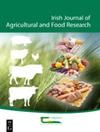Ecological value of different vegetated strip types in providing valuable insect-rich habitats for grey partridge chicks
IF 1.4
4区 农林科学
Q3 AGRICULTURE, MULTIDISCIPLINARY
引用次数: 1
Abstract
The intensification and specialisation of agriculture has contributed to farmland wildlife decline, including farmland birds. Grey partridge is a farmland species which has experienced a significant decline across Europe in recent decades. Chick survival rate is a key determinant of grey partridge population change and depends essentially on the availability of insect food. In this study, ground-dwelling and canopy-dwelling insects were collected using pitfall trapping and sweep netting methodologies, respectively, on different strip types in an area established for the conservation of grey partridge. The aim was to further our understanding of the value of different vegetated strip types in providing insect-rich habitats for grey partridge chicks. Overall, wildflower strip (WS) provided the greatest insect abundance. Significantly more ground-dwelling insects were found on WS, natural regeneration (NS) and leguminous strips (LS) than on grass strip (GS). Canopy-dwelling insects were also significantly more abundant on WS compared to all other strip types. This study highlights that WSs may represent important habitats in providing insect-rich food for grey partridge chicks and sowing these strips may therefore play a key role in decreasing chick mortality and supporting grey partridge conservation. It also demonstrates that other different vegetated strip types may still provide strip-specific insect taxa, in addition to other valuable resources. This study recommends a complex mosaic of different strip types to provide key resources for grey partridge, such as insect and plant food, nesting habitats and overwinter cover.不同植被带类型为灰鹧鸪雏鸟提供丰富昆虫栖息地的生态价值
农业的集约化和专业化导致了包括农田鸟类在内的农田野生动物的减少。灰鹧鸪是一种农田物种,近几十年来在欧洲各地经历了显著的衰退。鸡的存活率是灰鹧鸪种群变化的关键决定因素,主要取决于昆虫食物的可获得性。在这项研究中,在为保护灰鹧鸪而建立的区域内,分别使用陷阱诱捕法和扫网法在不同的条形上收集了地面和树冠昆虫。目的是进一步了解不同植被带类型在为灰鹧鸪雏鸟提供昆虫丰富的栖息地方面的价值。总体而言,野花带(WS)提供了最大的昆虫丰度。在WS、自然再生带(NS)和豆科带(LS)上发现的地栖昆虫明显多于草带(GS)。与所有其他带状昆虫相比,WS上的冠层昆虫数量也明显更多。这项研究强调,WSs可能代表着为灰鹧鸪雏鸟提供富含昆虫的食物的重要栖息地,因此,播种这些条带可能在降低雏鸟死亡率和支持灰鹧蝓保护方面发挥关键作用。它还表明,除了其他有价值的资源外,其他不同的植被条带类型仍然可以提供条带特有的昆虫分类群。这项研究推荐了不同条带类型的复杂马赛克,为灰鹧鸪提供关键资源,如昆虫和植物食物、筑巢栖息地和越冬覆盖。
本文章由计算机程序翻译,如有差异,请以英文原文为准。
求助全文
约1分钟内获得全文
求助全文
来源期刊
CiteScore
2.50
自引率
20.00%
发文量
23
审稿时长
>36 weeks
期刊介绍:
The Irish Journal of Agricultural and Food Research is a peer reviewed open access scientific journal published by Teagasc (Agriculture and Food Development Authority, Ireland). Manuscripts on any aspect of research of direct relevance to Irish agriculture and food production, including plant and animal sciences, food science, agri environmental science, soils, engineering, buildings, economics and sociology, will be considered for publication. The work must demonstrate novelty and relevance to the field of research. Papers published or offered for publication elsewhere will not be considered, but the publication of an abstract does not preclude the publication of the full paper in this journal.

 求助内容:
求助内容: 应助结果提醒方式:
应助结果提醒方式:


